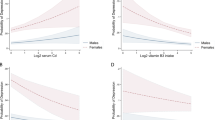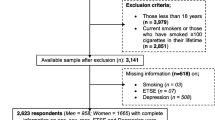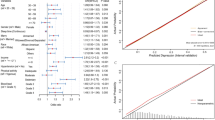Abstract
The association of formaldehyde exposure with depression remains unknown. We used the data from National Health and Nutrition Examination Survey (NHANES) 2015–2016 to evaluate the association between formaldehyde exposure and depression. Multivariable logistic regressions and restricted cubic spline (RCS) were implemented to examine the association between formaldehyde exposure and depression. A total of 1336 participants were included in the analysis, of which 110 (8.23%) participants were depressed. After adjusting for confounders, a significant association between formaldehyde exposure and depression (OR = 1.01, 95% CI: 1.00–1.02, P = 0.043) was observed. The RCS plot showed a positive association in a linear manner (PNonlinear = 0.109), and the risk began to rise rapidly with concentrations above 129.37 nmol/g HB. The positive association remained in participants with high-intensity physical activity (OR = 1.08, 95% CI: 1.02–1.13, P = 0.003), but not in participants with other physical activities. Moreover, we constructed a novel nomogram to easily estimate the individual-specific probabilities of depression. In conclusion, formaldehyde exposure was associated with an elevated risk of depression, and the effect exhibited differences in participants with different levels of physical activity.



Similar content being viewed by others
Data availability
All data used in this study are available on the NHANES website.
References
Attia D, Mansour N, Taha F, Seif El Dein A (2016) Assessment of lipid peroxidation and p53 as a biomarker of carcinogenesis among workers exposed to formaldehyde in the cosmetic industry. Toxicol Ind Health 32:1097–1105
Augenreich M, Stickford J, Stute N, Koontz L, Cope J, Bennett C, Ratchford SM (2020) Vascular dysfunction and oxidative stress caused by acute formaldehyde exposure in female adults. American journal of physiology. Heart and Circul Physiol 319:H1369-h1379
Bakunina N, Pariante CM, Zunszain PA (2015) Immune mechanisms linked to depression via oxidative stress and neuroprogression. Immunology 144:365–373
Bellisario V, Mengozzi G, Grignani E, Bugiani M, Sapino A, Bussolati G, Bono R (2016) Towards a formalin-free hospital. Levels of 15–F2t-isoprostane and malondialdehyde to monitor exposure to formaldehyde in nurses from operating theatres. Toxicol Res 5:1122–1129
Bhatt S, Nagappa AN, Patil CR (2020) Role of oxidative stress in depression. Drug Discovery Today 25:1270–1276
Böhm M, Salem MZ, Srba J (2012) Formaldehyde emission monitoring from a variety of solid wood, plywood, blockboard and flooring products manufactured for building and furnishing materials. J Hazard Mater 221–222:68–79
Bono R, Romanazzi V, Munnia A, Piro S, Allione A, Ricceri F, Guarrera S, Pignata C, Matullo G, Wang P, Giese RW, Peluso M (2010) Malondialdehyde-deoxyguanosine adduct formation in workers of pathology wards: the role of air formaldehyde exposure. Chem Res Toxicol 23:1342–1348
Bono R, Munnia A, Romanazzi V, Bellisario V, Cellai F, Peluso MEM (2016) Formaldehyde-induced toxicity in the nasal epithelia of workers of a plastic laminate plant. Toxicol Res 5:752–760
Bouayed J, Rammal H, Soulimani R (2009) Oxidative stress and anxiety: relationship and cellular pathways. Oxid Med Cell Longev 2:63–67
Buser MC, Scinicariello F (2017) Cadmium, lead, and depressive symptoms: analysis of National Health and Nutrition Examination Survey 2011–2012. J Clin Psychiatry 78:e515–e521
Chen L, Cai M, Li H, Wang X, Tian F, Wu Y, Zhang Z, Lin H (2022) Risk/benefit tradeoff of habitual physical activity and air pollution on chronic pulmonary obstructive disease: findings from a large prospective cohort study. BMC Med 20:70
Collaborators GMD (2022) Global, regional, and national burden of 12 mental disorders in 204 countries and territories, 1990–2019: a systematic analysis for the Global Burden of Disease Study 2019. The Lancet Psychiatry 9:137–150
Hammen C (2018) Risk factors for depression: an autobiographical review. Annu Rev Clin Psychol 14:1–28
He R (2017) Formaldehyde and cognition [M]. Springer
Hosgood HD 3rd, Zhang L, Tang X, Vermeulen R, Hao Z, Shen M, Qiu C, Ge Y, Hua M, Ji Z, Li S, Xiong J, Reiss B, Liu S, Xin KX, Azuma M, Xie Y, Freeman LB, Ruan X, Guo W, Galvan N, Blair A, Li L, Huang H, Smith MT, Rothman N, Lan Q (2013) Occupational exposure to formaldehyde and alterations in lymphocyte subsets. Am J Ind Med 56:252–257
Huang B, Huang Z, Tan J, Xu H, Deng K, Cheng J, Ren Z, Gong X, Gao Y (2021) The mediating and interacting role of physical activity and sedentary behavior between diabetes and depression in people with obesity in United States. J Diabetes Complications 35:107764
IARC Working Group on the Evaluation of Carcinogenic Risks to Humans (2012) Chemical agents and related occupations. IARC Monogr Eval Carcinog Risks Hum 100(Pt F):9–562
Jacobson MH, Ghassabian A, Gore AC, Trasande L (2022) Exposure to environmental chemicals and perinatal psychopathology. Biochem Pharmacol 195:114835
Kilburn KH, Warshaw RH (1992) Neurobehavioral effects of formaldehyde and solvents on histology technicians: repeated testing across time. Environ Res 58:134–146
Kilburn KH, Warshaw R, Thornton JC (1987) Formaldehyde impairs memory, equilibrium, and dexterity in histology technicians: effects which persist for days after exposure. Arch Environ Health 42:117–120
Kroenke K, Spitzer RL, Williams JB (2001) The PHQ-9: validity of a brief depression severity measure. J Gen Intern Med 16:606–613
Kroenke K, Spitzer RL, Williams JB, Löwe B (2010) The patient health questionnaire somatic, anxiety, and depressive symptom scales: a systematic review. Gen Hosp Psychiatry 32:345–359
Letellier N, Gutierrez LA, Pilorget C, Artaud F, Descatha A, Ozguler A, Goldberg M, Zins M, Elbaz A, Berr C (2022) Association between occupational exposure to formaldehyde and cognitive impairment. Neurology 98:e633–e640
Li Y, Song Z, Ding Y, Xin Y, Wu T, Su T, He R, Tai F, Lian Z (2016) Effects of formaldehyde exposure on anxiety-like and depression-like behavior, cognition, central levels of glucocorticoid receptor and tyrosine hydroxylase in mice. Chemosphere 144:2004–2012
Li HR, Fu XH, Song LL, Cen MQ, Wu J (2023) Association between pyrethroid exposure and risk of depressive symptoms in the general US adults. Environ Sci Pollut Res Int 30:685–698
Lino-dos-Santos-Franco A, Domingos HV, de Oliveira AP, Breithaupt-Faloppa AC, Peron JP, Bolonheis S, Muscará MN, Oliveira-Filho RM, Vargaftig BB, Tavares-de-Lima W (2010) Differential effects of formaldehyde exposure on the cell influx and vascular permeability in a rat model of allergic lung inflammation. Toxicol Lett 197:211–218
Lino-dos-Santos-Franco A, Correa-Costa M, Durão AC, de Oliveira AP, Breithaupt-Faloppa AC, Bertoni Jde A, Oliveira-Filho RM, Câmara NO, Marcourakis T, Tavares-de-Lima W (2011) Formaldehyde induces lung inflammation by an oxidant and antioxidant enzymes mediated mechanism in the lung tissue. Toxicol Lett 207:278–285
Manea L, Gilbody S, McMillan D (2015) A diagnostic meta-analysis of the Patient Health Questionnaire-9 (PHQ-9) algorithm scoring method as a screen for depression. Gen Hosp Psychiatry 37:67–75
Marwaha S, Palmer E, Suppes T, Cons E, Young AH, Upthegrove R (2023) Novel and emerging treatments for major depression. Lancet (london, England) 401:141–153
Mei Y, Duan C, Li X, Zhao Y, Cao F, Shang S, Ding S, Yue X, Gao G, Yang H, Shen L, Feng X, Jia J, Tong Z, Yang X (2016) Reduction of endogenous melatonin accelerates cognitive decline in mice in a simulated occupational formaldehyde exposure environment. Int J Environ Res Public Health 13(3):258
Padilla CR, Spiker CM, Beltran TA, Berry-Cabán CS, Choi YS (2020) Normative formaldehyde-hemoglobin adduct levels among the US population: analysis of the 2013–2016 National Health and Nutrition Examination Survey. Clin Biochem 86:61–64
Paolucci EM, Loukov D, Bowdish DME, Heisz JJ (2018) Exercise reduces depression and inflammation but intensity matters. Biol Psychol 133:79–84
Park J, Kang GH, Kim Y, Lee JY, Song JA, Hwang JH (2022) Formaldehyde exposure induces differentiation of regulatory T cells via the NFAT-mediated T cell receptor signalling pathway in Yucatan minipigs. Sci Rep 12:8149
Rahman HH, Niemann D, Munson-McGee SH (2022) Association among urinary polycyclic aromatic hydrocarbons and depression: a cross-sectional study from NHANES 2015–2016. Environ Sci Pollut Res Int 29:13089–13097
Ran J, Zhang Y, Han L, Sun S, Zhao S, Shen C, Zhang X, Chan KP, Lee RS, Qiu Y, Tian L (2021) The joint association of physical activity and fine particulate matter exposure with incident dementia in elderly Hong Kong residents. Environ Int 156:106645
Shcherbakova LN, Tel’pukhov VI, Trenin SO, Bashilov IA, Lapkina TI (1986) Permeability of the blood-brain barrier to intra-arterial formaldehyde. Biull Eksp Biol Med 102:573–575
Tian X, Xue B, Wang B, Lei R, Shan X, Niu J, Luo B (2022) Physical activity reduces the role of blood cadmium on depression: a cross-sectional analysis with NHANES data. Environ Pollut 304:119211
Usanmaz SE, Akarsu ES, Vural N (2002) Neurotoxic effects of acute and subacute formaldehyde exposures in mice. Environ Toxicol Pharmacol 11:93–100
Wu Y, Song J, Zhang Q, Yan S, Sun X, Yi W, Pan R, Cheng J, Xu Z, Su H (2023a) Association between organophosphorus pesticide exposure and depression risk in adults: a cross-sectional study with NHANES data. Environ Pollut 316:120445
Wu Y, Wu Q, Pan R, Yi W, Li Y, Jin X, Liang Y, Mei L, Yan S, Sun X, Qin W, Song J, Cheng J, Su H (2023b) Phenotypic aging mediates the association between blood cadmium and depression: a population-based study. Environ Sci Pollut Res Int 30(15):44304–44315
Yan T, Ding X, Xie T, Lan T, Niu D, Li J, Guo D, Wang M, Wang M (2023) Physical activity (PA) influences the risk of depression associated with long working hours. J Affect Disord 321:227–233
Yang M, Ospina M, Tse C, Toth S, Caudill SP, Vesper HW (2017) Ultraperformance liquid chromatography tandem mass spectrometry method to determine formaldehyde hemoglobin adducts in humans as biomarker for formaldehyde exposure. Chem Res Toxicol 30:1592–1598
Zhang T, Luo J, Ge H, Hao K, Wang Z, Zhang D (2022) Relationships between urinary antimony concentrations and depressive symptoms in adults. Chemosphere 291:133104
Funding
This study was supported by grants from the Jiangsu Postdoctoral Research Foundation (2020Z146).
Author information
Authors and Affiliations
Contributions
Kaipeng Xie and Shijuan Mei contributed to the study conception and design. Data collection and analysis were performed by Kaipeng Xie and Bo Xu. The first draft of the manuscript was written by Bo Xu and Kaipeng Xie. Wanke Wu and Qi Liu revised the manuscript critically. All authors commented on previous versions of the manuscript. All authors read and approved the final manuscript.
Corresponding author
Ethics declarations
Ethical approval
The Ethics Review Board (ERB) of National Center for Health Statistics (NCHS) approved the surveys.
Consent to participate
All the participants signed informed consents and the detailed information are available on the NHANES website.
Consent for publication
Consent was given by all the authors.
Competing interests
The authors declare no competing interests.
Additional information
Responsible Editor: Lotfi Aleya
Publisher's note
Springer Nature remains neutral with regard to jurisdictional claims in published maps and institutional affiliations.
Rights and permissions
Springer Nature or its licensor (e.g. a society or other partner) holds exclusive rights to this article under a publishing agreement with the author(s) or other rightsholder(s); author self-archiving of the accepted manuscript version of this article is solely governed by the terms of such publishing agreement and applicable law.
About this article
Cite this article
Xu, B., Mei, S., Wu, W. et al. Association of formaldehyde concentration with depression risk in US adults: a population-based epidemiology study. Environ Sci Pollut Res 30, 98261–98270 (2023). https://doi.org/10.1007/s11356-023-29290-2
Received:
Accepted:
Published:
Issue Date:
DOI: https://doi.org/10.1007/s11356-023-29290-2




